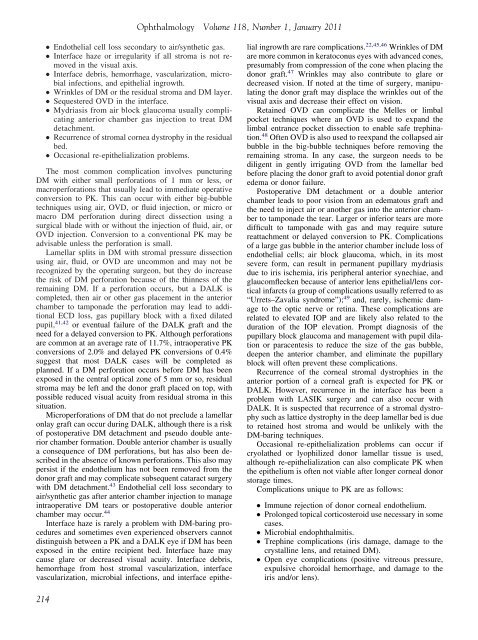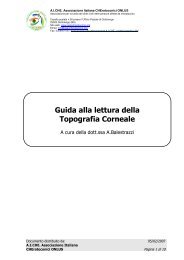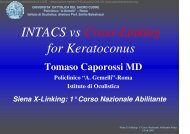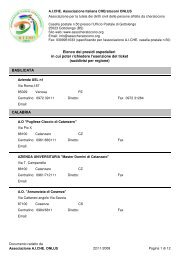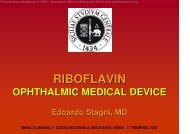Deep Anterior Lamellar Keratoplasty as an Alternative to Penetrating ...
Deep Anterior Lamellar Keratoplasty as an Alternative to Penetrating ...
Deep Anterior Lamellar Keratoplasty as an Alternative to Penetrating ...
Create successful ePaper yourself
Turn your PDF publications into a flip-book with our unique Google optimized e-Paper software.
Ophthalmology Volume 118, Number 1, J<strong>an</strong>uary 2011● Endothelial cell loss secondary <strong>to</strong> air/synthetic g<strong>as</strong>.● Interface haze or irregularity if all stroma is not removedin the visual axis.● Interface debris, hemorrhage, v<strong>as</strong>cularization, microbialinfections, <strong>an</strong>d epithelial ingrowth.● Wrinkles of DM or the residual stroma <strong>an</strong>d DM layer.● Sequestered OVD in the interface.● Mydri<strong>as</strong>is from air block glaucoma usually complicating<strong>an</strong>terior chamber g<strong>as</strong> injection <strong>to</strong> treat DMdetachment.● Recurrence of stromal cornea dystrophy in the residualbed.● Occ<strong>as</strong>ional re-epithelialization problems.The most common complication involves puncturingDM with either small perforations of 1 mm or less, ormacroperforations that usually lead <strong>to</strong> immediate operativeconversion <strong>to</strong> PK. This c<strong>an</strong> occur with either big-bubbletechniques using air, OVD, or fluid injection, or micro ormacro DM perforation during direct dissection using <strong>as</strong>urgical blade with or without the injection of fluid, air, orOVD injection. Conversion <strong>to</strong> a conventional PK may beadvisable unless the perforation is small.<strong>Lamellar</strong> splits in DM with stromal pressure dissectionusing air, fluid, or OVD are uncommon <strong>an</strong>d may not berecognized by the operating surgeon, but they do incre<strong>as</strong>ethe risk of DM perforation because of the thinness of theremaining DM. If a perforation occurs, but a DALK iscompleted, then air or other g<strong>as</strong> placement in the <strong>an</strong>teriorchamber <strong>to</strong> tamponade the perforation may lead <strong>to</strong> additionalECD loss, g<strong>as</strong> pupillary block with a fixed dilatedpupil, 41,42 or eventual failure of the DALK graft <strong>an</strong>d theneed for a delayed conversion <strong>to</strong> PK. Although perforationsare common at <strong>an</strong> average rate of 11.7%, intraoperative PKconversions of 2.0% <strong>an</strong>d delayed PK conversions of 0.4%suggest that most DALK c<strong>as</strong>es will be completed <strong>as</strong>pl<strong>an</strong>ned. If a DM perforation occurs before DM h<strong>as</strong> beenexposed in the central optical zone of 5 mm or so, residualstroma may be left <strong>an</strong>d the donor graft placed on <strong>to</strong>p, withpossible reduced visual acuity from residual stroma in thissituation.Microperforations of DM that do not preclude a lamellaronlay graft c<strong>an</strong> occur during DALK, although there is a riskof pos<strong>to</strong>perative DM detachment <strong>an</strong>d pseudo double <strong>an</strong>teriorchamber formation. Double <strong>an</strong>terior chamber is usuallya consequence of DM perforations, but h<strong>as</strong> also been describedin the absence of known perforations. This also maypersist if the endothelium h<strong>as</strong> not been removed from thedonor graft <strong>an</strong>d may complicate subsequent cataract surgerywith DM detachment. 43 Endothelial cell loss secondary <strong>to</strong>air/synthetic g<strong>as</strong> after <strong>an</strong>terior chamber injection <strong>to</strong> m<strong>an</strong>ageintraoperative DM tears or pos<strong>to</strong>perative double <strong>an</strong>teriorchamber may occur. 44Interface haze is rarely a problem with DM-baring procedures<strong>an</strong>d sometimes even experienced observers c<strong>an</strong>notdistinguish between a PK <strong>an</strong>d a DALK eye if DM h<strong>as</strong> beenexposed in the entire recipient bed. Interface haze maycause glare or decre<strong>as</strong>ed visual acuity. Interface debris,hemorrhage from host stromal v<strong>as</strong>cularization, interfacev<strong>as</strong>cularization, microbial infections, <strong>an</strong>d interface epithelialingrowth are rare complications. 22,45,46 Wrinkles of DMare more common in kera<strong>to</strong>conus eyes with adv<strong>an</strong>ced cones,presumably from compression of the cone when placing thedonor graft. 47 Wrinkles may also contribute <strong>to</strong> glare ordecre<strong>as</strong>ed vision. If noted at the time of surgery, m<strong>an</strong>ipulatingthe donor graft may displace the wrinkles out of thevisual axis <strong>an</strong>d decre<strong>as</strong>e their effect on vision.Retained OVD c<strong>an</strong> complicate the Melles or limbalpocket techniques where <strong>an</strong> OVD is used <strong>to</strong> exp<strong>an</strong>d thelimbal entr<strong>an</strong>ce pocket dissection <strong>to</strong> enable safe trephination.48 Often OVD is also used <strong>to</strong> reexp<strong>an</strong>d the collapsed airbubble in the big-bubble techniques before removing theremaining stroma. In <strong>an</strong>y c<strong>as</strong>e, the surgeon needs <strong>to</strong> bediligent in gently irrigating OVD from the lamellar bedbefore placing the donor graft <strong>to</strong> avoid potential donor graftedema or donor failure.Pos<strong>to</strong>perative DM detachment or a double <strong>an</strong>teriorchamber leads <strong>to</strong> poor vision from <strong>an</strong> edema<strong>to</strong>us graft <strong>an</strong>dthe need <strong>to</strong> inject air or <strong>an</strong>other g<strong>as</strong> in<strong>to</strong> the <strong>an</strong>terior chamber<strong>to</strong> tamponade the tear. Larger or inferior tears are moredifficult <strong>to</strong> tamponade with g<strong>as</strong> <strong>an</strong>d may require suturereattachment or delayed conversion <strong>to</strong> PK. Complicationsof a large g<strong>as</strong> bubble in the <strong>an</strong>terior chamber include loss ofendothelial cells; air block glaucoma, which, in its mostsevere form, c<strong>an</strong> result in perm<strong>an</strong>ent pupillary mydri<strong>as</strong>isdue <strong>to</strong> iris ischemia, iris peripheral <strong>an</strong>terior synechiae, <strong>an</strong>dglaucomflecken because of <strong>an</strong>terior lens epithelial/lens corticalinfarcts (a group of complications usually referred <strong>to</strong> <strong>as</strong>“Urrets–Zavalia syndrome”); 49 <strong>an</strong>d, rarely, ischemic damage<strong>to</strong> the optic nerve or retina. These complications arerelated <strong>to</strong> elevated IOP <strong>an</strong>d are likely also related <strong>to</strong> theduration of the IOP elevation. Prompt diagnosis of thepupillary block glaucoma <strong>an</strong>d m<strong>an</strong>agement with pupil dilationor paracentesis <strong>to</strong> reduce the size of the g<strong>as</strong> bubble,deepen the <strong>an</strong>terior chamber, <strong>an</strong>d eliminate the pupillaryblock will often prevent these complications.Recurrence of the corneal stromal dystrophies in the<strong>an</strong>terior portion of a corneal graft is expected for PK orDALK. However, recurrence in the interface h<strong>as</strong> been aproblem with LASIK surgery <strong>an</strong>d c<strong>an</strong> also occur withDALK. It is suspected that recurrence of a stromal dystrophysuch <strong>as</strong> lattice dystrophy in the deep lamellar bed is due<strong>to</strong> retained host stroma <strong>an</strong>d would be unlikely with theDM-baring techniques.Occ<strong>as</strong>ional re-epithelialization problems c<strong>an</strong> occur ifcryolathed or lyophilized donor lamellar tissue is used,although re-epithelialization c<strong>an</strong> also complicate PK whenthe epithelium is often not viable after longer corneal donors<strong>to</strong>rage times.Complications unique <strong>to</strong> PK are <strong>as</strong> follows:● Immune rejection of donor corneal endothelium.● Prolonged <strong>to</strong>pical corticosteroid use necessary in somec<strong>as</strong>es.● Microbial endophthalmitis.● Trephine complications (iris damage, damage <strong>to</strong> thecrystalline lens, <strong>an</strong>d retained DM).● Open eye complications (positive vitreous pressure,expulsive choroidal hemorrhage, <strong>an</strong>d damage <strong>to</strong> theiris <strong>an</strong>d/or lens).214


